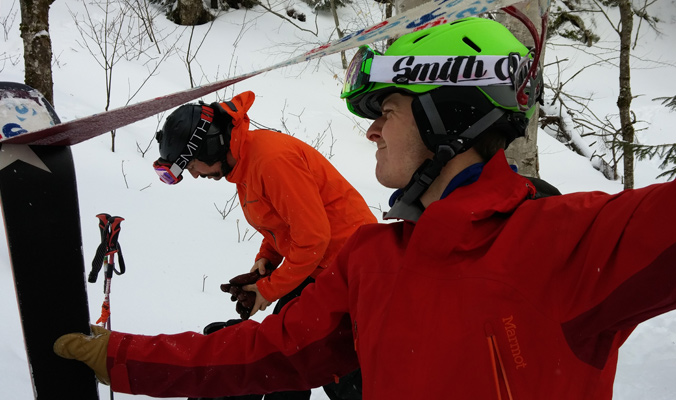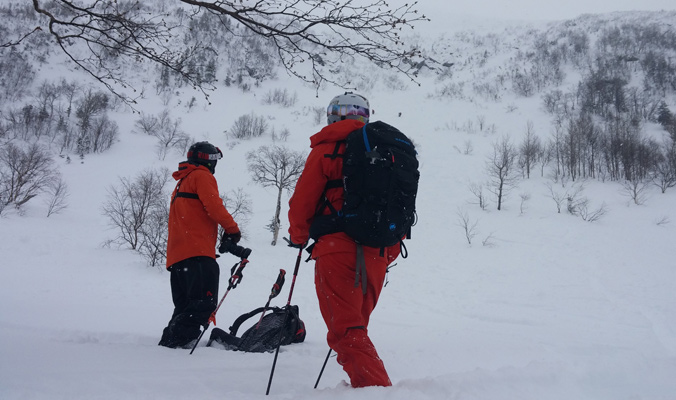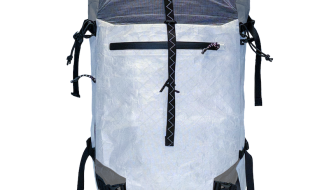This article was originally posted in Spring, 2017.
It’s a spring day in the Eastern Sierra, and I’m watching the helmet that was attached to my backpack skim its way down the soft yet firm mountainside—poor attaching skills on my part. It accelerates and bounces down the slope before it manages to nestle into the run-out zone. I now have to bootpack and ski down without a helmet in chutes surrounded by rocks and inconsistent snow. The feeling is a little unnerving, since I almost always wear a helmet. But as strange as the absence of a helmet seems to me, there are many skiers and riders who elect not to bring their brain buckets into the bc. To reconcile this weight vs. safety conundrum, I dug into the topic a bit.
The Stats
According to the National Ski Areas Association (NSAA), 80 percent of skiers and snowboarders wear helmets at U.S. ski resorts. Through an annual NSAA helmet study that began in the 2002-03 season, the organization reports that this trend has been growing for the past 14 years. Unfortunately, no specific data collection has taken place to determine the number of backcountry skiers venturing out with or without helmets.
Helmet technology has advanced over recent years with the advent of MIPS, a technology comprised of a layer inside a helmet to help to reduce rotational motion transferred to the brain, as well as Smith’s Koroyd honeycomb material that disperses the force of an impact. But even with this evolution in head protection, skiers continue to travel in the backcountry without helmets, citing that convenience is king when it comes to bc travel.
“I typically don’t wear a helmet into the backcountry,” says Wilson Koontz, a ski instructor and guide in the Tahoe and Yosemite area. “I typically do [less exposed] lines and don’t generally have to worry about other people. Also, I don’t like the weight of the helmet on the uphill.”
But for others, safety is paramount in the backcountry due to the variable risks that are present on any given excursion.

Ben Bruno and Dana Allen choose to wear helmets despite the added weight. [Photo] Louise Lintilhac
If there are more factors that could contribute to a catastrophic accident, then why not take into consideration having a helmet for accompaniment?
Here are a few factors to consider before you leave your helmet at home.
Is it worth the weight, the space, or the hassle?
The backcountry ski industry has grown to the point where creating the lightest and highest performing gear is an industry-wide mission. And when some skiers and riders obsess over every milligram, a helmet can tip the decision–making scales.
In the backcountry, getting hurt or falling isn’t something we intend to do, but it is an inherent risk of the sport. Dr. Jasper Shealy, Emeritus Principal and Human Factors Engineer at Guidance Engineering is a lead researcher in ski-safety knowledge and history and has devoted 40 years to researching ski-related injuries. Through his research, he’s found that fatality rates have virtually stayed the same even with more helmet usage countrywide.
“It’s kind of paradoxical,” Shealy reports, going on to explain that the circumstances of death versus head injuries are quite different. “Death is usually a fairly high-speed collision against a fixed object,” he says. “The magnitude overwhelms what even a helmet could protect.”
More extensively, he and his team found that helmets were most effective in preventing or moderating skull fractures as well as helping to guard the skull against lacerations. The take-away? If you are going to take a major blow directly to the head at moderate speed, a helmet may not save your life every time, but depending on the circumstances, it just might, and may well protect against injuries.
Helmets in Avalanches
According to Shealy, the leading cause of head injuries on the slopes is skiers hitting trees. Sometimes, that tree-related trauma is a result of being swept into one during an avalanche. One longstanding observational case study, Patterns of death among avalanche fatalities: a 21-year review, determined that 33 percent of avalanche deaths in Western Canada resulted from major trauma—42 percent of this percentage was head-trauma related—and trees were noted as a major contributor to trauma deaths throughout the country. Conversely, an Austrian study included a lower number of 5.6 percent—the difference being that trees were not a major contributor to head-related trauma in that study.
While trees may not always be a factor with avalanches, slides alone can create a lot of hazard. Boulder-sized ice chunks and fast-moving slopes of snow can thrash a body caught in a slide.
Pro skier Amie Engerbretson knows this first hand. In 2013, she was fully buried in an avalanche at Grizzly Gulch, Utah.
“Slides often rip through terrain features, like rocks and trees, and our heads are a valuable yet fragile piece of our body,” says Engerbretson. “I think it’s a good idea to have something between your head and the elements.”
While no formal studies have been conducted specifically on the role of helmets in backcountry and avalanche safety, Engerbretson’s tale strikes a convincing chord.

“Beacon, shovel, probe, avy bag…helmet?” [Photo] Louise Lintilhac
Future of Helmets in the Backcountry
Statistical evidence aside, there are anecdotal cases where helmets have saved lives. One such story comes from big mountain rider Xavier de Le Rue, who recently revealed on social media that he had a near-death accident in Verbier, Switzerland. A mellow powder day turned into a nightmare when he was knocked out by rocks after catching his board. After being admitted to the hospital, his doctor explained that the dent on his helmet indicated that he most likely would have died without head protection.
Helmet technology is constantly adapting, but it’s clear to Byrd that there’s still a lot to learn about protecting the brain.
“Right now, helmets are only protective at speeds up to 14 miles per hour,” Byrd explains. “That’s pretty slow when the average skier skis at a speed of 27 miles per hour.”
Hopefully, that will change soon. Companies like G-Form, MIPS, and even POC’s future SPIN technology are teaming up with helmet brands in attempt to lower the effect of brain movement in an accident. The new research could have profound impacts on helmet effectiveness for both bc and resort skiing and riding, but only time will tell.
Bottom Line: Despite the hassle and issue of weight savings, helmets may be worth bringing along anyway. As Engerbretson puts it, “Maybe they won’t always help, but it certainly can’t hurt.”










There’s an old saying…….
You put a $200 helmet on a $200 Head…..
You put a $100 helmet on a $100 Head………..
And you put a $0 on $0 Head…………..
Just Saying…………..
Hahaha! Best answer!
mine was $80 on sale so…. dang….
Hahaha! X) best answer!
I put a good 80 bucks on one for sale! so that means….
Helmets got it’s gashes already! I prefer them to be in plastic than on my head. There’s always that rogue tree branch.
Have always worn one at resorts where possible collisions with other skiers aren’t always in your control. Just this year I started wearing one on the descent in the BC. Otherwise it stays attached to my pack unless I’m climbing in sketchy terrain or in a skimo race (required for up and down).
I have been operating a medical clinic at a ski area for 33 years. Since the advent and popularity of helmets we have seen an increase, not a decrease, in head injuries. It is unclear if this is due to adverse behavioral effects due not only to helmets but also easier to use equipment, glorification of risk taking behavior, etc. What is clear is that despite an overwhelming majority of people using helmets I have not seen a benefit. . It is difficult to argue that a helmet is ever a bad thing so if the cost of using one for you is small, feel free. Just don’t depend on it to compensate for otherwise risky behavior.
You’re seeing more head injuries because you are now trained to look for head injuries. Ten years ago, a concussion was only suspected and diagnosed with a loss of consciousness. Raised awareness in recent years causes skiers to be much more cognizant of their melon.
Also keep in mind that developments in technology generally allow people to travel faster and ski harder lines that they were 33 years ago. Increase in number of skiers on the mountain also plays a role.
I wear one because I am bald nothing like a little insulation as well as protection. I take the ear pads off and it makes the helmet more comfortable.
I wear a helmet when ski mountaineering due to rockfall and falling on a exposed face, however I do not wear one when backcountry skiing. I work as a ski patroller and see a lot of head injurys but the worst ones are always wearing helmets ( probably because most skiers wear them). I think the ski industry should look into ways to make helmets lighter and more breathable like the climbing industry does so carrying one isn’t so bad and you could possibly wear it on the uptrack. There could be a market for lightweight ski touring helmets.
The weight is a non-issue, and most packs have an easy pocket or strap for the helmet. Rocks are hard as trees, and even when caught in debris, the helmet will give you a little extra pocket. No way I am going BC without one.
Statistically helmets make very little difference to accident rates and outcomes even though there are anecdotal examples of helmets saving someone’s life. If you want to wear one then that’s your choice. The notion that people who don’t wear helmets are somehow foolish is a myth. There is psychological research that indicates that as people adopt and use more safety gear their subconscious risk tolerance increases thereby negating any actual safety benefit.
The interesting thing is that the single greatest cause (by far) of traumatic head injuries is motor vehicle accidents and yet nobody arrives at the ski hill wearing a helmet in their car.
Skiing and cycling are relatively safe sports despite the helmet hype. Wear a helmet or not – it’s your choice but if you really want to improve your personal safety wear a helmet in your car.
After two pretty serious concussions and broken legs, I feel naked without a helmet on the mountain and I used to oppose to wear one. Sure, it might give some people a feeling that they can risk more, but coming from my personal experience, I want my helmet to crack, not my skull. It gives me confidence that I can negate some mistakes with a bit more confidence, especially riding in trees.
At 50 years old, I definitely grew up in the era when wearing a helmet would have earned you severe ridicule, and I’ve resisted helmets all my life unless racing or on street motorcycles. But, I am increasingly considering adding a helmet to all backcountry activities, because as a solo hiker/survivalist, the last thing I want to end my life is an inadvertent slip and crack on my noggin.
as always, better to bring it and not need it, than to need it and not bring it… are we do e being too cool for school ?!
When your brain is going 20 mph & all of sudden it stops, your head/body hits a tree, or. A hemet does not correct what has just happened inside your cranium. Its still scrambeled eggs.
WEAR A HELMET
https://www.youtube.com/watch?v=6TyThGeBdXM
Helmet at the resort and helmet in the BC. The only times I don’t have a helmet are for mellow powder skiing where there’s lots of snow and no rocks, and backyard jibs.
If you ski under control, at reasonable speeds, you probably don’t need a helmet in the BC. People are so fearful these days. Helmets, Airbags, etc. Sure, if you’re jumping off cliffs, a helmet might be a good idea. But seriously, skiing perfect powder on Teton Pass? I don’t think so.
Seems like industry marketing rather than a necessity. Somehow, people survived skiing without helmets until about 10 years ago. I rarely ski at resorts, but don’t wear one there and don’t wear one in the BC. And I don’t wear one when I’m backpacking off trail where the chances of hitting my head on a rock are pretty high, nor does anyone else. But I’ll bet it’s only a matter of time before the industry convinces the buyers that they need a helmet to get out of bed.